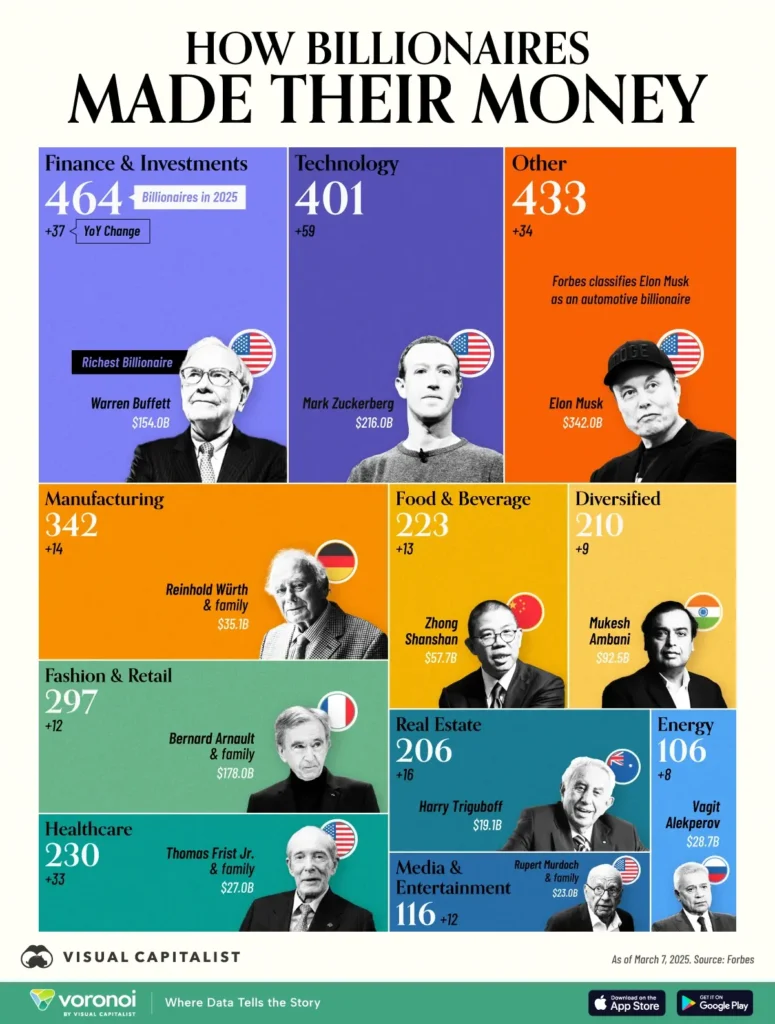In 2025, Billionaire Wealth 2025 continues its upward trajectory, not just in aggregate net worth, but in how that wealth is held, preserved, and passed through billionaire families across generations. Latest reports show the global billionaire population has grown, their combined fortunes have surged, and multigenerational wealth is playing an increasingly prominent role in shaping wealth dynamics.
This article explores the most recent billionaire statistics, examines key trends among elite families, dives into generational wealth dynamics, and outlines the challenges and opportunities facing billionaires in 2025. Whether you’re a wealth manager, investor, policy analyst, or simply curious, the insights here help illuminate how the ultra-wealthy world is shifting.
1. Current Billionaire Statistics: The State of Billionaire Wealth in 2025
Growth in Number & Combined Net Worth
- As of 2025, there are approximately 3,028 billionaires globally, up from ~2,781 the prior year, marking a net addition of ~247 individuals. Inequality.org
- Their combined wealth has reached around US$16.1 trillion, a rise of about $2 trillion over the previous year. Inequality.org
Geographic Distribution & Density
- The United States leads strongly, with 902 billionaires, significantly more than any other country. Investopedia
- Other leading countries include China (including Hong Kong), India, and various European nations. Investopedia
- Billionaire density (billionaires per capita or per adult population) remains concentrated in North America and Western Europe; emerging markets show growth but still lag in density.
Top Industries & Wealth Sources
- Technology, finance, consumer goods, software/AI, and real estate remain among the top sources of billionaire wealth. VisualCapitalist’s rankings show many billionaires derive their fortunes from tech or tech-adjacent enterprises. Visual Capitalist
- Family business inheritances (retail, industrial) continue to form the base for many top billionaire families (Walton, Al Saud, Koch, etc.) especially in consumer/luxury sectors. Business Insider Africa

2. Billionaire Families & Multigenerational Wealth: Who Holds the Reins
Prominent Billionaire Families in 2025
- Walton Family (USA) retains a top spot among billionaire families, with combined wealth in the hundreds of billions, largely from Walmart. Bloomberg.com, Business Insider Africa
- Other major dynasties include Al Saud (Saudi Arabia), Al Nahyan (UAE), Hermès in France, Mars family, and Koch family in the United States. These families span industries like luxury goods, oil & gas, retail, and diversified holdings. Business Insider Africa Businessday NG
How Wealth Is Preserved Across Generations
- Families use structures such as family offices, trusts, holding companies, and diversified investment portfolios to preserve wealth across generations.
- Many top billionaire family offices are increasing allocations to stable real estate, alternative assets (art, luxury assets), private equity, and other non-liquid but long-term appreciating assets. Reports (Knight Frank etc.) note this trend. Knight Frank
- Succession planning is increasingly formalized: clearer legal frameworks, inter-generational mentorship, and more transparency among heirs.
Newest Generations and Inheritances
- Some families are seeing younger heirs (often third or fourth generation) taking more visible roles, often influenced by newer values: ESG, socially responsible investing, giving back, sustainability.
- In some cases, heirs are being groomed in business operations or serving in governance roles earlier; in others, the wealth is more passively inherited but expectations for legacy and social impact are shifting.
3. Key Trends & Drivers in Billionaire Wealth Dynamics
Economic Conditions & Market Forces
- Strong equity markets, especially in tech and AI, have played a major role in increasing valuations for many billionaire holdings.
- Currency strength, inflation, interest rates, and global macro conditions influence net worth, especially for those with assets in multiple jurisdictions.
Regulatory, Tax, and Policy Influences
- Increasing scrutiny around taxation of the super-rich; proposals in many jurisdictions for wealth taxes, higher inheritance or estate taxes, more disclosure requirements.
- Regulatory risks: antitrust, corporate governance, environmental regulation can affect industries many billionaires are in (tech, fossil fuels, real estate).
Wealth Inequality & Social Pressures
- The gap between top billionaires and even high net worth individuals is widening in many countries. The societal role of billionaires is under greater scrutiny: philanthropy expectations, climate impact, ethics.
- Public pressure and activism influence policy, investment decisions, and reputational risk.
Innovation, Technology, & Disruption
- Emerging technologies (AI, biotech, green energy, digital infrastructure) continue to create rapid wealth for founders and early investors. Some younger billionaires are first generation (built wealth rather than inherited).
- Disruption can also threaten established industries, meaning some families diversify or shift investments to stay ahead.
4. Challenges & What Billionaires Need to Adapt
Risks Threatening Multigenerational Wealth
- Market volatility: stock crashes or downturns can erode large paper gains.
- Inflation, interest rate spikes, real estate corrections can affect asset bases heavily exposed.
- Cross-border legal and tax complexities: many billionaire families hold assets globally, making them vulnerable to changing laws and currency risk.
Succession & Governance Problems
- Poor succession planning or conflicts among heirs can lead to dilution or erosion of wealth.
- Governance of family offices, balancing control vs innovation, resisting complacency in newer generations.
Reputation, ESG, and Social License to Operate
- Increasing expectation for billionaire families to commit to environmental, social, and governance (ESG) criteria. Benchmarks, transparency, giving back matter more.
- Philanthropy is becoming less optional; social scandals or perceptions of inequality can impose costs (regulatory, tax, brand).
Opportunities for Growth & Reinvention
- Diversification into emerging markets, alternative assets, sustainable businesses.
- Investing in technologies and sectors of the future (AI, renewable energy, climate mitigation).
- Leveraging family brand, legacy, and reputation for impact investing or social enterprises.
5. Outlook & Actionable Insights
- Forecasts suggest billionaire wealth will continue to grow in 2025–2026, especially in US, Asia (Greater China, India), and sectors like tech/AI, renewables.
- Families that formalize governance, invest in heir education, diversify assets, and are flexible with changing norms will likely preserve their wealth and influence more successfully.
- On the policy front, legal/tax environments will be critical – both risk and opportunity for billionaire families depending on jurisdiction.
In 2025, Billionaire Wealth 2025 is not just a story of rising numbers or net worth. It’s a complex interplay of industry, geography, family legacy, innovation, regulation, and social expectations. The richest families are not merely accumulating wealth—they are learning how to maintain it across generations, navigating a world of greater scrutiny, change, and uncertainty.
“True wealth for billionaires isn’t measured simply in billions, but how that wealth endures – through governance, values, adaptation, and legacy.”
Actionable Takeaway: If you are part of a billionaire family, an heir, or an advisor to one, start with robust succession planning, diversify globally, invest in next-generation leadership, and anticipate regulatory shifts. For investors interested in entering billionaire-grade wealth dynamics, aligning with emerging tech sectors, sustainable infrastructure, or family offices that value long-term impact may provide the strongest upside.
People Also Asked (FAQs)
- How many billionaires are there in 2025?
As of 2025, there are about 3,028 billionaires globally, up from ~2,781 in the previous year. The combined net worth of these billionaires is around US$16.1 trillion. Inequality.org - Which billionaire families have the most generational wealth?
Prominent examples include the Walton family (USA), Al Nahyan (UAE), Al Saud (Saudi Arabia), Hermès (France), Koch family (USA), among others. These families have preserved wealth through inheritance, diversified assets, family offices, and strong succession planning. Business Insider Africa , Businessday NG - What industries are driving billionaire wealth growth in 2025?
Key industries include technology (especially AI, digital platforms), finance, real estate, consumer goods/luxury, industrials, and energy. Many billionaires’ wealth is driven by ownership in private companies, equity holdings, and high-growth sectors. Visual Capitalist - How is multigenerational wealth maintained in billionaire families?
Through strategies like family offices, trusts, holding companies; by diversifying across asset classes and geographies; investing in next generation leadership; formal governance; and adapting to regulatory/tax changes. Also, by preserving brand or business culture as part of legacy. - What challenges do billionaire families face in preserving wealth across generations?
- Conflict among heirs, poor succession planning.
- Tax, regulatory, and policy changes.
- Asset risks (market crashes, inflation, real estate downturn).
- Reputation risk and pressure for social / environmental impact.


